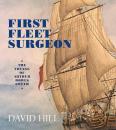AustLit
Latest Issues
AbstractHistoryArchive Description
'In a single leather-bound volume of 238 unlined pages of parchment, Surgeon Arthur Bowes Smyth describes his two-and-a-half year journey with the First Fleet from Portsmouth in England to the new colony in Australia and back. He is a frank, articulate and observant writer, and his diary, a treasure of the National Library of Australia, covers life at sea, stopovers in the slave port of Rio de Janeiro and the tropical paradise of Tahiti, and three months of early settlement in Australia.
'As surgeon to more than 100 convict women on the Lady Penrhyn, Bowes Smyth gives an insight into the plight of these women, sentenced to transportation, and their children. Their voyage was marked by seasickness, miscarriage, infant deaths, a diet of salted meat and dry hardtack biscuits, and cruel punishment from thumb screws to gagging and flogging with a cat-o’-nine-tails. When they finally set foot on Australian soil, their travails did not end, being set upon by drunken sailors and crew in a ‘scene of debauchery and riot’.
'Bowes Smyth also describes medical incidents that would make a modern reader squirm, from extracting a ‘jigger worm’ from his own foot to a scurvy outbreak which resulted in bleeding noses, contracted muscles, emaciated bodies and swollen, blackening limbs. There are moments of high drama when mountainous seas threaten to overturn the ship or when passengers fall overboard, as well as calm days at sea spotting porpoises, whales, seals and all manner of sea birds.
Upon finally reaching Botany Bay, Bowes Smyth describes ‘the joy which possessed every breast upon so long wished for an event’. He details early encounters with Aboriginal people and the struggles in setting up the new colony, which was plagued from the outset by food shortages, outbreaks of disease and crop failures. He also describes the promiscuity and lax morals of the convicts with typical flair, declaring their audacity ‘not to be equalled amongst a set of villains in any other part of the globe’.
'In First Fleet Surgeon, author David Hill brings to life the voyage of the Lady Penrhyn and the early months of settlement at Port Jackson (modern-day Sydney) through Bowes Smyth’s colourful language and frank anecdotes. Each chapter includes a page of Bowes Smyth’s handwritten diary entries accompanied by a full transcript, and is richly illustrated with paintings, lithographs and maps from the National Library of Australia’s collection. Information boxes on subjects such as eighteenth-century medical knowledge, brewing beer on board, and a surgeon’s typical day provide context to Bowes Smyth’s story. ' (Publication summary)
Publication Details of Only Known VersionEarliest 2 Known Versions of
Works about this Work
-
[Review Essay] First Fleet Surgeon : The Voyage of Arthur Bowes Smyth
2016
single work
essay
— Appears in: Journal of Australian Colonial History , no. 18 2016; (p. 227-229)'Arthur Bowes Smyth was chief surgeon on the Lady Penrhyn, the one of the eleven ships of the First Fleet that carried exclusively female convicts. As well as writing a regular diary for the round journey to Australia and back from 1787 to 1789, he ensured the best health of the convicts and crew by a programme of meticulous cleanliness and good order. As he was not a regular employee of the Royal Navy, but on loan with the ship from the East India Company, he could express independent views in his diary, though he kept several copies with his more acid comments deleted from the ones most likely to be submitted to his superiors.' (Introduction)
-
Review : First Fleet Surgeon
2015
single work
review
— Appears in: The Courier-Mail , 13 June 2015; (p. 19)
— Review of First Fleet Surgeon : The Voyage of Arthur Bowes Smyth 2015 single work biography -
[Untitled]
2015
single work
review
— Appears in: The Advertiser , 9 May 2015; (p. 32)
— Review of First Fleet Surgeon : The Voyage of Arthur Bowes Smyth 2015 single work biography -
Dissecting a Surgeon’s Time in Colonial NSW
2015
single work
review
— Appears in: The Weekend Australian , 2-3 May 2015; (p. 22)
— Review of First Fleet Surgeon : The Voyage of Arthur Bowes Smyth 2015 single work biography
-
Dissecting a Surgeon’s Time in Colonial NSW
2015
single work
review
— Appears in: The Weekend Australian , 2-3 May 2015; (p. 22)
— Review of First Fleet Surgeon : The Voyage of Arthur Bowes Smyth 2015 single work biography -
[Untitled]
2015
single work
review
— Appears in: The Advertiser , 9 May 2015; (p. 32)
— Review of First Fleet Surgeon : The Voyage of Arthur Bowes Smyth 2015 single work biography -
Review : First Fleet Surgeon
2015
single work
review
— Appears in: The Courier-Mail , 13 June 2015; (p. 19)
— Review of First Fleet Surgeon : The Voyage of Arthur Bowes Smyth 2015 single work biography -
[Review Essay] First Fleet Surgeon : The Voyage of Arthur Bowes Smyth
2016
single work
essay
— Appears in: Journal of Australian Colonial History , no. 18 2016; (p. 227-229)'Arthur Bowes Smyth was chief surgeon on the Lady Penrhyn, the one of the eleven ships of the First Fleet that carried exclusively female convicts. As well as writing a regular diary for the round journey to Australia and back from 1787 to 1789, he ensured the best health of the convicts and crew by a programme of meticulous cleanliness and good order. As he was not a regular employee of the Royal Navy, but on loan with the ship from the East India Company, he could express independent views in his diary, though he kept several copies with his more acid comments deleted from the ones most likely to be submitted to his superiors.' (Introduction)




